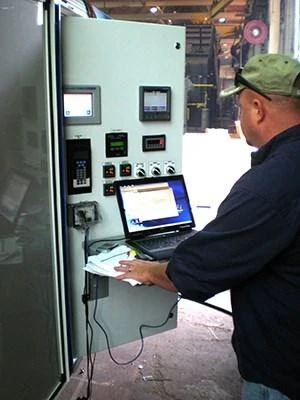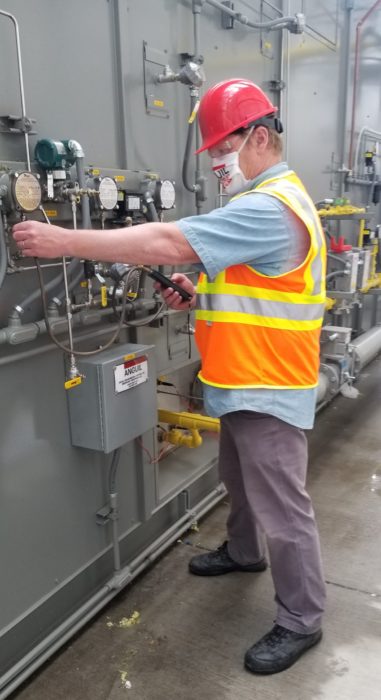The Challenge
OXIDIZER SERVICE SERIES: PART 2
Having documentation and spare parts readily available is a great start to being proactive and maintaining effective system operation, but what if you could catch a potential issue before it becomes one? Whether it is still on the drawing boards or has been on site for years, your air pollution control system represents a significant investment and a long-term commitment to environmental compliance. A well-crafted maintenance plan for your oxidizer will allow you to get the most from your investment over the entire life of the system.
The Solution
Many will come to this article hoping for a one-size-fits-all checklist for maintaining an oxidizer system. As a company that offers service on any oxidizer regardless of style or original manufacturer, we at Anguil have long wanted the same. A set recipe for success would certainly make life easier. For those in need of a quick answer or a starting point from which to grow, we do not wish to disappoint. Absent of knowing anything else about the operating context of a particular oxidizer system, our best recommendation for a basic maintenance plan is as follows:
service on any oxidizer regardless of style or original manufacturer, we at Anguil have long wanted the same. A set recipe for success would certainly make life easier. For those in need of a quick answer or a starting point from which to grow, we do not wish to disappoint. Absent of knowing anything else about the operating context of a particular oxidizer system, our best recommendation for a basic maintenance plan is as follows:
- Gather all the system documentation as listed in Part 1 of our Oxidizer Service Series. Make sure this documentation is readily available to both system operators and service providers.
- Stock the recommended spare parts for your oxidizer system (more on this in Part 3 of our Oxidizer Service Series)
- Establish a monthly checklist of system inspection points and make sure your own operators are comfortable with what to look for and how to record their findings
- Maintain an operator log book or journal of system issues
- Obtain a yearly Preventive Maintenance Evaluation (PME) from an independent or third party oxidizer service provider such as Anguil
- Establish remote access capability to your system’s controls from an oxidizer service provider such as Anguil
Some may choose to take this basic recommendation for a maintenance plan, stop reading here, and run with it. We would agree that anyone complying with all of the steps as outlined above is indeed making a defensible effort at maintaining their oxidizer system; however, having an Oxidizer Service Provider like Anguil visit your site for a couple days could jump-start the implementation of such a plan.
Maintenance Plan Drivers
The following drivers make the decision to implement an oxidizer maintenance plan imperative:
Production Uptime – An informed staff and a transparent maintenance plan will allow for maximum production uptime, prevent costly shutdowns, and enable a prepared response to operational irregularities.
Compliance with Environmental Regulations – Being out of compliance can be costly and a public relations disaster. The language in many air permits requires operators to stock spare parts, keep historical service documentation, and maintain the system according to the manufacturer’s recommendations.
Compliance with Safety Regulations – Compliance codes often require that safety checks be performed on an annual basis for this class of equipment. Anguil incorporates these safety checks as a part of our 75+ point Preventative Maintenance Evaluation.
Operating Cost Reduction – A good maintenance plan will often pay for itself by ensuring that your oxidizer system is running at peak efficiency and with minimal downtime.
Maintenance Plan Building Blocks
The right maintenance plan for one company might not be the right plan for another. Anguil considers the following to be the building blocks of a comprehensive maintenance plan that can be customized to fit the needs of any operating context.
- System Documentation – Gather all your system documentation in one binder as outlined in Part 1 of our Oxidizer Service Series. Make sure this documentation is readily available to both system operators and service providers. We recommend storing
inside the control panel.
- Recommended Spare Parts Package – An Oxidizer Service Provider like Anguil can identify the critical components, recommended components, and convenience items that you should stock to maintain smooth operation of your system and limit production down time.
- Annual Preventive Maintenance Evaluation (PME) – Often done by an Oxidizer Service Provider like Anguil. This is not just our advice. This is rapidly becoming part of Permit Codes and Compliance – both environmental codes and safety codes. Anguil’s standard PME program includes a 2-3 day service visit utilizing a 75+ point checklist to ensure your oxidizer is meeting air pollution control standards and is followed by a formal report for your maintenance records.
The next four options can be performed in conjunction with a PME visit or ordered separately as stand-alone services.
- Destruction Removal Efficiency (DRE) Check-Ups – An oxidizer service provider like Anguil can check the VOC destruction efficiency of your system with portable testing equipment or via laboratory analysis of air samples. This service keeps you on track with system performance and verifies compliance. It is ideal as a pre-test to help eliminate “surprises” during expensive formal compliance testing.
- Repeat Operator Training – Maintenance personnel take pride in servicing the equipment if they are familiar with the operation. Years one and two of an oxidizer’s life can present different maintenance challenges than years three through fifteen. Repeat training can keep operating personnel prepared to meet evolving service needs. Repeat Operator Training is showing up in the NFPA codes as well.
- Catalyst Services – At the heart of every Catalytic Oxidizer System is the catalyst bed. Properly maintained, the catalyst bed can provide years of high VOC Destruction at temperatures well under those required for thermal oxidation. Anguil offers a full program of catalyst services including Evaluation and Testing, Rejuvenation, Replacement, and the purchase back of “spent” catalyst for recycling.
- Split Preventative Maintenance Evaluations – Some facilities have little precious downtime for system repairs, so they want to be prepared with the right parts and contractors to act on repairs immediately when their downtime occurs. They may elect a Split-PME scenario, which starts with a one day system evaluation visit by a Field Service Engineer. A second visit is scheduled and the Field Service Engineer returns with all parts and materials identified in the system evaluation, prepared to execute on the service recommendations immediately.
- Semi-Annual Preventative Maintenance Evaluations – For some, the yearly comprehensive Preventive Maintenance Evaluation is not enough. Overall system balancing, operational cost verification, and inventory of spare parts should be conducted semi-annually. Depending on the complexity of your system, you may wish to contact Anguil to perform this service for you.
- Remote Login Capability – Remote log-in could be your lifeline in emergency situations. Establishing this capability is one of the most important things you can do when devising your maintenance plan. Remote Access Capability has recently become a game changer in the oxidizer service world. For the companies and oxidizer systems we service, when the capability is in place, it is both a lifeline during system upsets as well as a “force-multiplier” when our Field Service Engineers are on a particular site. One need only walk into our Service Manager’s office during a live-connection event and see two or three additional heads observing the system operation in real-time while conversing directly with our Field Service Engineer on site. It is akin to getting the experience and knowledge of several engineers on site for the price of one. In today’s world, no oxidizer end-user should be left behind without this critical safety net in place. Don’t wait for an emergency to find out the connection isn’t there. Anguil can also perform routine operational checks remotely and potentially identify developing service issues proactively for a fraction of the cost of an on site visit. Adding this service quarterly is rapidly becoming a popular option. For those with this feature, make sure to regularly test your connection.
- Operating Cost Review – Do you know exactly how much your system should be costing you to run? Are you getting the most for your operating dollars? Anguil offers an Operating Cost Review Program that can answer these questions for you and provide cost savings recommendations tailored for your oxidizer system.
- Operator Log Book – Thorough service history documentation, including a historical account of daily, weekly, and annual inspections, is often an air permit requirement. Like a doctor’s medical records, a comprehensive operator log will help diagnose operating irregularities and could prevent costly malfunctions down the road.
- Weekly Walk-By Inspections – Typically performed by your own personnel. An Oxidizer Service Provider like Anguil can custom design weekly inspection checklists for your specific oxidizer system.
- Deeper Monthly/Maintenance Day Inspection Checklists – For our Monthly Inspections program, we provide a list of the system components needing inspection, independent verification, and/or calibration on a monthly basis. Our goal is to train your maintenance teams to feel comfortable performing the monthly checks on their own.
- Custom Maintenance Plans – Multi-Year and Multi-Facility Packages
- Developing a custom maintenance plan with an Oxidizer Service Provider can result in a strong service relationship built on trust and long-term oxidizer expertise. Anguil’s custom maintenance plans include multi-year deals for individual plants or across multiple facilities. Custom multi-year and multi-facility maintenance plans can offer numerous benefits:
- Smooth Equipment Turnover Between Project Engineering and Production Engineering Teams – Many oxidizer systems are purchased via a project engineering team who then must turn the equipment over to production teams. This hand-off can proceed much smoother if the production team sees that there is a service agreement already in place.
- Reliable Budgeting – Having a multi-year service plan can take some guesswork out of operational budgeting.
- Consistent Service History – even as plant personnel may turn over.
- Knowledge Sharing – Maintaining service history at the plant level can be difficult enough. A corporate level maintenance plan can become a conduit for improved knowledge sharing between plants.
- Uphold Corporate Values – Environmental Compliance is often part of your Corporate Level Mission Statement.
Reliability Centered Maintenance
Anguil recently participated in a three-week-long Reliability Centered Maintenance (RCM) evaluation of an oxidizer system. This particular system treats the exhaust from a critical production line in one of the most highly regulated areas of the country. RCM is a landmark maintenance concept defined in John Moubray’s book Reliability-Centered Maintenance as “a process used to determine the maintenance requirements of any physical asset in its operating context.”
For this RCM evaluation, a team of Anguil Personnel along with the facility’s maintenance personnel, equipment operators, electrical controls specialists, and EHS staff was assembled and guided by an RCM facilitator. The team went line-by-line through the oxidizer electrical schematics, the sequence of operation, the control programs and the environmental permit requirements to define the system’s functions and possible functional failures. Using the framework of the RCM program, the team generated lists of potential redesigns, required procedures, a compulsory spare parts program, and implementation reports for the system as a whole. This was no small task — the final report was over 400 pages long! The evaluation was a significant investment in both money and manpower for both Anguil and the company involved.
Our two biggest takeaways from this experience were:
- This is the level of training that operators of oxidizer systems deserve but rarely get
- The importance of “Operating Context” in determining a suitable approach to long term maintenance of a particular oxidizer system
To further illustrate the idea of operating context, consider that oxidizers today are being installed into production scenarios where they:
- May be allowed to be offline for several weeks or months in a given year
- May force the end-user to stop all production immediately when offline, in some cases triggering “Notices of Violation” and fines upon any upset condition
- May be treating exhaust gas streams that are immediately dangerous to life and health
- May be the sole source of heat for the process to which they are attached
Each one of these different operating contexts can play a major role in the final determination of an appropriate maintenance plan for a particular oxidizer system.
Not everyone can afford to go to the lengths of implementing a formal RCM maintenance program for their oxidizer system. There are also plenty of industries with enough historically acquired experience where such an effort may not be required. However, an effective and custom maintenance plan adhering to minimum requirements can be crafted with help from an Oxidizer Service Company like Anguil and customized to your particular operating context. Such a program will prolong the life of your equipment while staying within the restraints of an operating budget.
The Result
In summary, there is no one-size-fits-all solution for crafting a quality oxidizer safety and maintenance program. At Anguil, we strive to offer a full menu of reliability services to make crafting even the most basic maintenance plan an essential and affordable investment. Our experienced service personnel look forward to assisting you in designing the smartest maintenance program for your company.
This is the second of four parts in Anguil’s Oxidizer Service Series. We encourage you to also view Part 1: Better Maintenance Starts With Better Documentation as well as Part 3: Stocking Spare Parts for Your Oxidizer System and Part 4: Oxidizer System Optimization.

 inside the control panel.
inside the control panel.